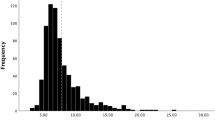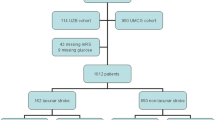Abstract
Hyperglycemia at the time of ischemic stroke has been associated with poorer outcomes. Preclinical literature suggests that hyperglycemia is an independent prognostic factor and the vasculature is more vulnerable to reperfusion injury. We applied a method to match subjects on important baseline factors to test whether, independent of stroke severity, stroke subtype influences the effect of hyperglycemia on outcome after recombinant tissue plasminogen activator (rt-PA). We reanalyzed the NINDS rt-PA dataset with respect to matching variables baseline NIHSS, age, and investigator-determined stroke subtypes small-vessel occlusive stroke (SVS), large-vessel occlusive stroke (LVS), and cardioembolic stroke (CES), above and below a glucose threshold of 150 mg/dl. Ninety-day outcomes were compared. Post hoc baseline matching was excellent in most cases. Hyperglycemia was associated with worsened functional outcome mostly in the LVS subtype with increased mortality in the placebo arm (15.3 % mortality normoglycemia vs. 30.6 % hyperglycemia; p = .046), worse functional outcome in the rt-PA arm (modified Rankin Score (mRS) 0–1; 46.3 vs. 22.0 %; p = .034), and no improvement in functional outcome with rt-PA compared to placebo (mRS 0–1; 25 % in both groups). Among hyperglycemic subjects, CES subjects showed significant improvement following rt-PA (p = .027). After matching for baseline severity, the influence of hyperglycemia on outcome was primarily in the LVS subtype, especially after rt-PA. This finding is consistent with a deleterious effect of hyperglycemia on ischemia/reperfusion of symptomatic large arteries. If confirmed, the particular vulnerability of the LVS subtype is important in understanding the role of stroke subtype in the mechanism of worsening and potential treatment of hyperglycemic stroke patients.


Similar content being viewed by others
References
Martini SR, Kent TA. Hyperglycemia in acute ischemic stroke: a vascular perspective. J Cereb Blood Flow Metab. 2007;27:435–51.
Bruno A, Levine SR, Frankel MR, et al. Admission glucose level and clinical outcomes in the NINDS rt-PA stroke trial. Neurology. 2002;59:669–74.
Demchuk AM, Morgenstern LB, Krieger DW, et al. Serum glucose level and diabetes predict tissue plasminogen activator-related intracerebral hemorrhage in acute ischemic stroke. Stroke. 1999;30:34–9.
Mishra NK, Davis SM, Kast M, et al. Comparison of outcomes following thrombolytic therapy among patients with prior stroke and diabetes in the Virtual International Stroke Trials Archive (VISTA). Diabetes Care. 2010;33:2531–7.
Capes SE, Hunt D, Malmberg K, et al. Stress hyperglycemia and prognosis of stroke in nondiabetic and diabetic patients: a systematic overview. Stroke. 2001;32:2426–32.
Yong M, Kaste M. Dynamic of hyperglycemia as a predictor of stroke outcome in the ECASS-II trial. Stroke. 2008;39:2749–55.
Poppe AY, Majumdar SR, Jeerakathi T, et al. Admission hyperglycemia predicts a worse outcome in stroke patients treated with intravenous thrombolysis. Diabetes Care. 2009;32:617–22.
Reiter M, Tueschl Y, Matz K, Seyfang L, Brainin M, et al. Diabetes and thrombolysis for acute stroke: a clear benefit for diabetics. Eur J Neurol. 2014;21:5–10.
Uyttenboogaart M, Koch MW, Stewart RE, et al. Moderate hyperglycaemia is associated with favourable outcome in acute lacunar stroke. Brain. 2007;130(Pt 6):1626–30.
Ntaios G, Egli M, Faouzi M, Michel P. J-shaped association between serum glucose and functional outcome in acute ischemic stroke. Stroke. 2010;41:2366–70.
Quast MJ, Wei J, Huang NC, Brender DG, et al. Perfusion deficit parallels exacerbation of cerebral ischemia/reperfusion injury in hyperglycemic rats. J Cereb Blood Flow Metab. 1997;17:553–9.
Fabian RH, Kent TA. Hyperglycemia accentuates persistent “functional uncoupling” of cerebral microvascular nitric oxide and superoxide following focal ischemia/reperfusion in rats. Translational Stroke Research. 2012;3:482–90.
Ergul A, Kelly-Cobbs A, Abdalla M, Fagan SC. Cerebrovascular complications of diabetes: focus on stroke. Endocrine, Metabolic & Immune Disorders – Drug Targets. 2012;12:148–58.
Elgebaly MM, Ogbi S, Li W, et al. Neurovascular injury in acute hyperglycemia and diabetes: a comparative analysis in experimental stroke. Translational Stroke Research. 2011;2:391–8.
Cipolla MJ, Godfrey JA. Effect of hyperglycemia on brain penetrating arterioles and cerebral blood flow before and after ischemia/reperfusion. Translational Stroke Research. 2010;1:127–34.
Mandava P, Kalkonde Y, Rochat R, Kent TA. A matching algorithm to address imbalances in study populations: application to the National Institute of Neurological Diseases and Stroke Recombinant Tissue Plasminogen Activator Acute Stroke Trial. Stroke. 2010;41:765–70.
Mandava P, Kent TA. A method to determine stroke trial success using multidimensional pooled control functions. Stroke. 2009;40:1803–10.
Mandava P, Krumpelman CS, Murthy SB, Kent TA. A critical review of stroke trial Analytical Methodology: outcome measures, study design, and correction for imbalances. In: Lapchak PA, Zhang JH, editors. Translational stroke research: from target selection to clinical trials. New York: Springer Series in Translational Stroke Research; 2012. p. 833–8.
Mandava P, Dalmeida W, Anderson JA, Thiagarajan P, Fabian RH, Weir RU, et al. A pilot trial of low-dose intravenous abciximab and unfractionated heparin for acute ischemic stroke. Translational Stroke Research. 2010;1:170–7.
Matlab. k-Nearest neighbor search and radius search. Matlab Statistics ToolboxTM users guide. 2014. Pp 16.12–16.22.
Friedman JH, Bentley HL, Finkel RA. An algorithm for finding best matches in logarithmic expected time. ACM Trans Math Softw. 1977;3:209–26.
Bergstralh EJ, Kosanke JL. Computerized matching of cases to controls. Technical report 56. http://www.mayo.edu/research/documents/biostat-56pdf/DOC-10026923. Accessed October 26, 2013.
Rosner B. Estimation of sample size and power for comparing two binomial proportions. Boston MA: In Fundamentals of Biostatistics. Seventh Edition. Brooks/Cole; 2006.
StatsToDo. Single calculation: power estimation. 2013. http://www.statstodo.com/SSizMcNemar_Pgm.php#Single. Accessed 26 Oct 2013.
Mandava P, Krumpelman CS, Shah JN, White DL, Kent TA. Quantification of errors in ordinal outcome scales using Shannon Entropy: effect on sample size calculations. PLoS One. 2013;8:e67754.
Bender S, Lange R. Adjusting for multiple testing—when and how? J Clin Epidemiol. 2001;54:343–9.
Schochet PZ. Technical methods report: guidelines for multiple testing in impact evaluations. NCEE 2008-4018 US Department of Education. 2008. http://ies.ed.gov/ncee/pdf/20084018.pdf
Dalgaard P. Power and the computation of sample sizes. Chapter 9: Introductory statistics with R. Springer. 2008. Pp 165–172.
Ellis PD. Power analyses and the detection of effect sizes. Chapter 3: The essential guide to effect sizes. Cambridge University Press. 2010. Pp 47–72.
Uchino K, Billheimer D, Cramer SC. Entry criteria and baseline characteristics predict outcome in acute stroke trials. Stroke. 2001;32:909–16.
Weimar C, König IR, Kraywinkel K, Ziegler A, Diener HC, German Stroke Study Group. Age and National Institutes of Health Stroke Scale Score within 6 hours after onset are accurate predictors of outcome after cerebral ischemia: development and external validation of prognostic models. Stroke. 2004;35:158–62.
Piironen K, Putaala J, Rosso C, Samson Y. Glucose and acute stroke. Evidence for an interlude. Stroke. 2012;43:898–902.
Bruno A, Kent TA, Coull BM, et al. Treatment of hyperglycemia in ischemic stroke (THIS): a randomized pilot trial. Stroke. 2008;39:384–9.
Johnston KC, Hall CE, Kissela BM, GRASP Investigators, et al. Glucose Regulation in Acute Stroke Patients (GRASP) trial: a randomized pilot trial. Stroke. 2009;40:3804–9.
Rosso C, Corvol JC, Pires C, et al. Intensive versus subcutaneous insulin in patients with hyperacute stroke: results from the randomized INSULINFARCT trial. Stroke. 2012;43:2343–9.
Bruno A, Williams LS, Kent TA. How important is hyperglycemia during acute brain infarction? Neurologist. 2004;10:195–200.
Acknowledgments
This work was supported by a pilot grant from the Institute of Clinical and Translational Research at the Baylor College of Medicine (TAK) and the Department of Veterans Affairs VISN 16 Pilot Grant Program.
Conflict of Interest
PM and TAK have received copyright protection for the name and algorithm pPAIRS©. They have no commercial interest in its use.
Author information
Authors and Affiliations
Corresponding authors
Additional information
A preliminary version of this manuscript was presented at the International Stroke Conference, February 2011.
Electronic supplementary material
Below is the link to the electronic supplementary material.
ESM 1
(DOC 444 kb)
Rights and permissions
About this article
Cite this article
Mandava, P., Martini, S.R., Munoz, M. et al. Hyperglycemia Worsens Outcome After rt-PA Primarily in the Large-Vessel Occlusive Stroke Subtype. Transl. Stroke Res. 5, 519–525 (2014). https://doi.org/10.1007/s12975-014-0338-x
Received:
Revised:
Accepted:
Published:
Issue Date:
DOI: https://doi.org/10.1007/s12975-014-0338-x




